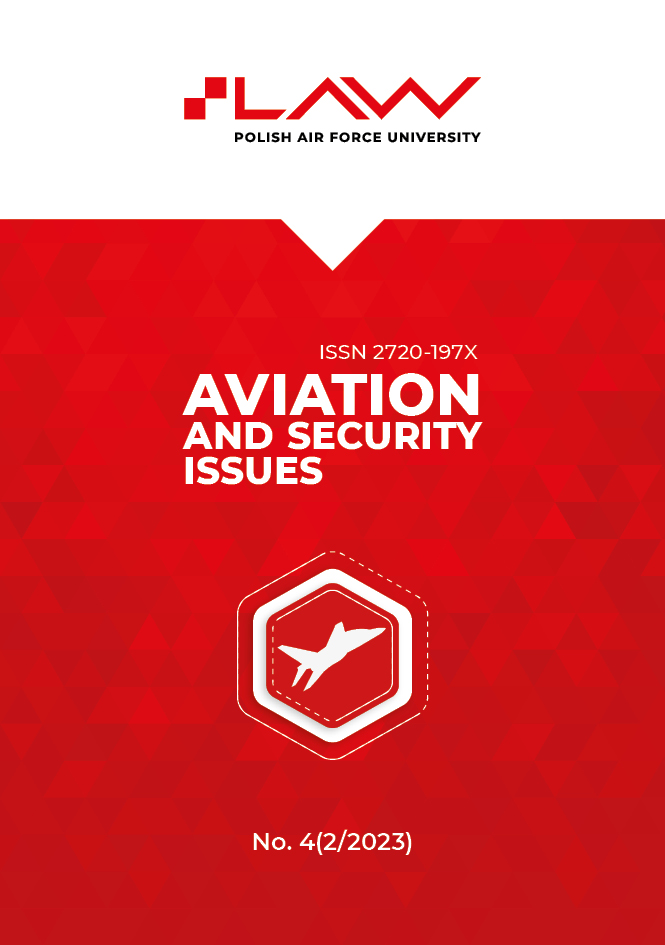FUNCTIONAL AND DESIGN ASSUMPTIONS FOR UNMANNED AERIAL VEHICLES INTENDED FOR RECONNAISSANCE AND MEDICAL OPERATIONS ON THE BATTLEFIELD
Main Article Content
Abstract
The purpose of this article is to present prototype design solutions as part of a project implemented for the Polish Armed Forces’ needs regarding the concept of unmanned aerial systems (UAS) as a two-level unmanned reconnaissance and medical system intended to acquire and provide information about the health condition of soldiers injured on the battlefield, as well as to provide initial medical aid. The article contains a summary of the functional and design aspects of the project, an overview of the products available on the market along with their characteristics and usability analysis, as well as a description of the original unmanned platform that meets the functional criteria formulated in the assumptions. The designed solutions, constitute a component of the battlefield logistic support system at various levels of medical support, will contain operational equipment adequate to perform individual tasks indicated in the project, including: human detection, downloading and sending data from the ground station to the platforms used in combat operations, delivering medical loads to the injured, measuring CO2 using a capnometer, performing measurements using the so-called noise radar.
Downloads
Article Details

This work is licensed under a Creative Commons Attribution-NonCommercial-NoDerivatives 4.0 International License.
References
Byung Duk Song, Kyungsu Park, Jonghoe Kim, Persistent UAV delivery logistics: MILP formulation and efficient heuristic, „Computers & Industrial Engineering” 2018, vol. 120, https://doi.org/10.1016/j.cie.2018.05.013.
Dokumentacja inicjująca projekt systemu MilGeoMed, ITWL, Warszawa 2020.
Fisher N., Gilbert G.R., Medical Robotic and Autonomous System Technology Enablers for the Multi-Domain Battle 2030–2050, „Small Wars Journal”, 22.07.2017, https://smallwarsjournal.com/jrnl/art/medical-robotic-and-autonomous-system-technology-enablers-for-the-multi-domain-battle-2030-2050.
https://hse-uav.com/product/commercial-drone-m6fa/.
https://www.aerialtechnology.com/.
https://www.ceeol.com/search/chapter-detail?id=824914.
https://www.dji.com/pl/matrice600-pro.
https://www.doosanmobility.com/en/.
https://www.dronetools.es/index.php#.
https://www.embention.com/product/m600-multirotor/.
https://www.foxtechfpv.com/gaia-160-hybrid-hexacopter-arf-combo.html.
https://www.harrisaerial.com/harris-carrier-h6-hydrone/.
https://www.yangdaonline.com/yangda-yd6-1600l-gas-electric-hybrid-hexacopter/.
https://www.yangdaonline.com/yangda-yd6-1600l-heavy-lift-hexacopter/.
https://www.quaternium.com/uav/hybrix-drone/.
Jacyna-Gołda I., Shmygol N., Gavkalova N., Salwin M., Sustainable Development of Intermodal Freight Transportation – Through the Integration of Logistics Flows in Ukraine and Poland, „Sustainability” 2024, nr 16(1), https://doi.org/10.3390/su16010267.
Jeler G.E., The use of autonomous systems for evacuation and medical support, [w:] International Scientific Conference Strategies XXI. The Complex and Dynamic Nature of the Security Environment, vol. 1, nov. 2019.
Lammers D.T., Williams J.M., Conner J.R., Baird E., Rokayak O., McClellan J.M. i in., Airborne! UAV delivery of blood products and medical logistics for combat zones, „Transfusion” 2023, nr 63(S3), https://doi.org/10.1111/trf.17329.
Li Yi, Min Liu, Dandan Jiang, Application of Unmanned Aerial Vehicles in Logistics: A Literature Review, „Sustainability” 2022, vol. 14, nr 21, https://doi.org/10.3390/su142114473.
McKnight G., Palmer M., Khan M., The use of Unmanned Aerial Vehicles for CASEVAC in the future urban and littoral environments, „Journal of The Royal Naval Medical Service” 2019, nr 105, http://dx.doi.org/10.1136/jrnms-105-29.
Rana K., Praharaj S., Nanda T., Unmanned Aerial Vehicles (UAVs): An Emerging Technology for Logistics, „Int. J. Bus. Manag. Invent.” 2016, nr 5.
Szulc T., Possibilities of using unmanned combat assets in tactical operations in the mountains, „Scientific Journal of the Military University of Land Forces” 2023, nr 55(208), DOI: 10.5604/01.3001.0053.7270.

